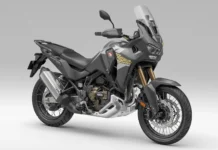Triumph has concluded testing its TE-1 prototype electric motorcycle, sharing performance figures and results from those trials. The TE-1 project was revealed in February 2022. It is Triumph’s first foray into electric motorcycles, and several collaborators are involved.
Funded by the Office of Zero Emission Vehicles through Innovate UK—both government agencies—the project sought “ground-breaking developments in specialist electric motorcycle engineering and innovative integrated technology design,” according to a Triumph spokesman. This led to the assembly of a who’s who of UK-based electric vehicle engineering.
A four-way partnership was formed between Triumph Motorcycles; Williams Advanced Engineering, the foundational developer of Formula E battery technology; e-powertrain manufacturer Helix; and WMG at the University of Warwick, which fosters collaborative efforts between academics and the private and public sectors. WMG is slated to work on the planned Norton electric motorcycle.
With the Triumph TE-1 prototype testing complete, questions about when or if Triumph will be bringing the TE-1 to market immediately rang out during an international teleconference. Although Triumph representatives were adamant that the TE-1 is not being released to the public, they were keen to acknowledge that the development, research, and partnerships advanced during the TE-1 program will influence future electric powertrains from Triumph. No timeline was given regarding when Triumph will release a battery-powered electric motorcycle.
Triumph Motorcycles Chief Product Officer Steve Sargent revealed some future product insights: “We have already seen an incredibly positive reaction to the TE-1 prototype from motorcyclists all around the world, where many people are telling us that for the first time, they are seeing an electric motorcycle as desirable, and something that they would genuinely want to own. Being the first step in our journey towards developing our future approach to electric powertrain technology, the TE-1 prototype and the incredible results it has achieved in its intensive testing program has provided crucial insights and capabilities that will ultimately guide our future development. Of course, the final production motorcycle will not be exactly what you see here today, but rest assured, the models we do develop will encompass all its learnings and its exciting, dynamic spirit.”
Triumph’s electric TE-1 prototype motorcycle resembles the Hinckley brand’s Speed Triple 1200 RS. Similarities are more than skin deep, as engineers aimed to achieve similar size, handling, geometry, weight distribution, and comparable performance to the ICE-powered Speed Triple 1200 RS. Other critical components, such as its Öhlins suspension and Brembo brakes, were lifted directly from its hydrocarbon-burning cousin.
The electric powertrain is claimed to produce peak performance figures of 130 kW (174 horsepower) and 80 ft-lbs of torque, spinning up to a lofty 17,500 rpm. The near instantaneous torque delivery of an electric motor is leveraged by the TE-1, achieving 0-60 mph in 3.6 seconds and 0-100mph in 6.2 seconds. The motor and inverter combined weigh 33 pounds, making the powertrain one of the lightest units in the segment today.
By comparison, Triumph claims that the Speed Triple 1200 RS makes 176 horsepower at 10,750 rpm and 92 ft-lbs of torque at 9000 rpm. From a standing start, the ST 1200 RS can run 0-60 mph in 3.1 seconds and 0-100 mph in 6.6 seconds.
A 15 kWh battery is employed, using a novel design of 900 individual cells distributed through eight different modules. This permits engineers to package the battery in a way that conforms to the shape of the motorcycle. This configuration allows for improved ground clearance and weight distribution. In addition, the smaller-capacity battery reduces overall weight significantly. Two independent cooling systems are used in the TE-1; the first cools the electric motor and inverter, while another is dedicated to the battery.
A 100-mile range is cited, although Triumph has not disclosed its testing or separated this figure into city/highway mileage.
Consumers are highly critical of the extended recharge times of electric vehicles, and these developments show promise. Of note are the 20-minute 0-80 percent recharge times achieved by a DC fast-charging system developed by WAE. The DC fast-charger uses a CHAdeMO adapter—used by many automobiles—which is likely to change when Triumph releases an e-powered model.
Features such as regenerative braking were developed in conjunction with a complete suite of rider aids. Four riding modes, cornering ABS, lean-angle-detecting traction control. Lastly, “walk” and reverse modes are available, with reverse functions typically relegated to heavyweight touring motorcycles.
Triumph has stated that the TE-1 tips the scales at an impressive 485 pounds, putting its claimed weight figures below comparable e-motorcycles such as the Energica Ego (573 pounds), LiveWire One (562 pounds), and Zero SR/S (518 pounds). The TE-1 does benefit from forgoing things such as turn signals and mirrors, due to its prototype nature. Still, it does appear to be in similar running order to comparable electric motorcycles.
We haven’t had a chance to ride the Triumph TE-1, but Daytona 200 champion and current MotoAmerica Superstock 1000 rider Brandon Paasch was on hand to perform some final tests.
Paasch shared his thoughts: “The throttle response on the TE-1 is kind of incredible. It’s very torquey, and when you first touch the throttle, it’s instant power, which is obviously what I love as a motorcycle racer. I love when it’s super-torquey and picks up right away. So for me, it was a really great experience”, said Brandon. “I got to peg this thing all the way from zero to 100 percent throttle, and it’s unbelievably quick. It pulls like crazy.”
Time will tell when Triumph enters the electric motorcycle segment. The TE-1 indicates potential, so we are in a good place. In many ways, the TE-1 looks ready for primetime with its well-sorted aesthetics, lighting, and other functionality, such as rider aids. Above all, the performance figures turn heads in the TE-1’s direction.






















![2024 Suzuki V-Strom 800 Touring First Look [Fast Facts + Photos] 2024 Suzuki V-Strom 800 Touring First Look: MSRP](https://ultimatemotorcycling.com/wp-content/uploads/2023/10/2024-suzuki-v-strom-800-touring-first-look-3-218x150.webp)
![2023 Motocross of Nations Results, Video [France Dominates] 2023 Motocross Of Nations Results](https://ultimatemotorcycling.com/wp-content/uploads/2023/10/2023-motocross-of-nations-start-218x150.jpg)

